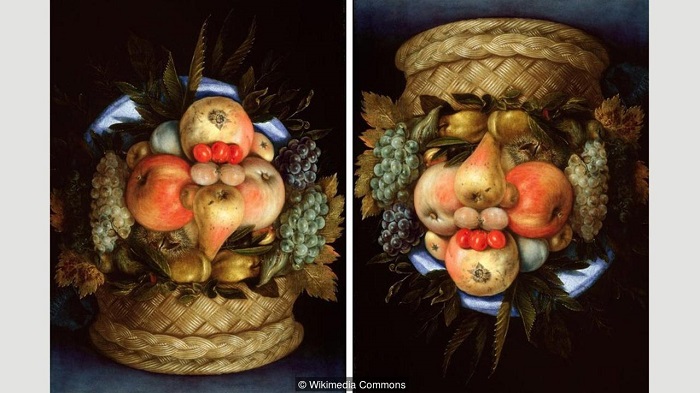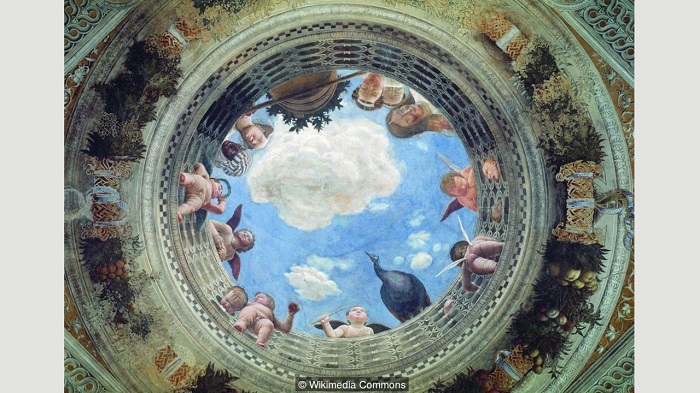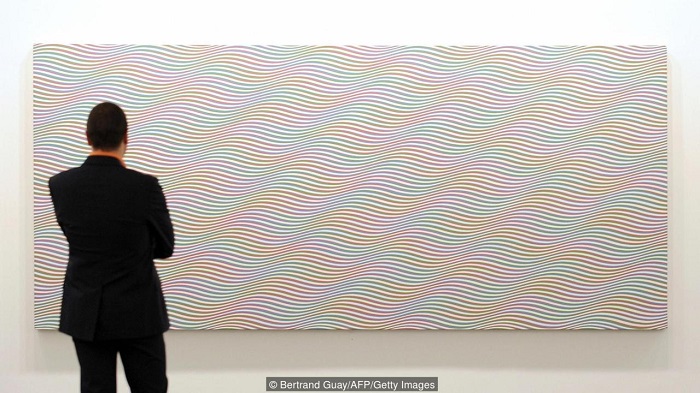
Tilt the painting one way and it is a vibrant heap of autumnal bounty, as apples, pears, grapes, and figs puzzle for position in an alluring, if seemingly conventional, still life. Flip the oil-on-panel work on its head, as if shaking loose the fruit that fills the wicker basket, and suddenly the plumped-up portrait of a stranger assembles itself from the bright jumble of assorted sweetness. The fibrous lashes of his chestnut eye wink at you playfully to punctuate the visual joke. Painted by the 16th Century Milanese Mannerist Giuseppe Arcimboldo, who would later inspire the imaginations of 20th Century Surrealist painters, Reversible Head With Basket of Fruit tricks the eye into the restless exercise of constructing and destroying one image in favour of the other. The result is a work that is at once amusing and profound – one that reminds the observer not only of the perishability of life but how our physical existence is comprised, materially, of the fragile world around us. (Credit: Wikimedia Commons)
Camera degli Sposi of the Ducal Palace, Mantua, Italy (circa 1465-74) by Andrea Mantegna

Camera degli Sposi of the Ducal Palace, Mantua, Italy (circa 1465-74) by Andrea MantegnaTo stand in the centre of the medieval bridal chamber of the Ducal Palace in Mantua and look up is to see the enclosed space magically widen above you. Suddenly, a shaft of unalterably beautiful blue sky beckons through a round aperture (or oculus) rimmed with angelic figures. Impossibly, the barrier of the ceiling appears to have dissolved, revealing an invisible architecture that telescopes towards heaven, thrusting your soul in the direction of the divine. The evaporative effect is the handiwork of Italian artist Andrea Mantegna – a genius of dramatic foreshortened perspective and depicting figures illusionistically di sotto in sù (or “below upwards”). Mantegna saw the flat surface of a canvas or ceiling as an opportunity to take an observer’s eye and soul on a spiritual journey inwards, upwards, and outwards. Believed to be the first artist since antiquity to employ such an illusion as a dimension of interior design, Mantegna breathed new religious life into a pagan trick. (Credit: Wikimedia Commons)
All is Vanity (1892) by Charles Allan Gilbert

All is Vanity (1892) by Charles Allan GilbertStand close to the black-and-white drawing and it appears to be little more than a depiction of a familiar domestic interior scene: a woman sitting at her dressing table (or “vanity”) staring at her reflection in the mirror opposite. Step back, and the image, deprived of its scrutinisable details, curdles grimly into an all-encompassing skull, grinning gothically from the shadows. Once the two overlapping images are registered in the observer’s mind, the eye shuttles between comprehension of one and then the other, as they wrestle for priority. A contrivance of the illustrator Charles Allan Gilbert, the drawing offered American magazine readers in the closing years of the 19th Century a fresh and startling spin on the convention of the memento mori (or ‘remember you will die’) in art history, which typically took the form of a skull inserted somewhere in a painting to remind viewers of their mortality. Seen from a 21st Century perspective, the inherent preachiness of the drawing (which visually puns on the scriptural admonishment “Vanity of vanities, saith the Preacher, vanity of vanities; all is vanity”) seems more than a little misogynistic in its emphasis on feminine narcissism as the chief locus of damnable frivolity and vice. (Credit: Wikimedia Commons)
Drawing Hands (1948) by MC Escher

Drawing Hands (1948) by MC EscherUsed effectively, an optical illusion momentarily forces the observer to rethink the relationship between the real world that he or she inhabits and the one depicted in the work. No one understood the penetrative power of illusion better than the Dutch graphic artist MC Escher. In his mesmerisingly meta Drawing Hands (1948), Escher magics from the work’s sketchy surface a closed-circuitry of the-hand-creating-the-hand-creating which appear to defy the limitations of two-dimensional drawing. Obsessed with the mathematics of repeating patterns, Escher’s work was admired by leading contemporary physicists and philosophers. In Drawing Hands, the graphite point of the mirroring pencil appears to be the teensy conduit through which the artist’s existence simultaneously flows into being and dissolves into nothingness. Caught in Escher’s endless rotation, the viewer’s eye is left to run circles around itself. (Credit: public domain)
Galatea of the Spheres (1952) by Salvador Dalí

Galatea of the Spheres (1952) by Salvador DalíAt first glance, the dynamic painting appears to capture the outward propulsion, towards the viewer, of countless colourful atoms – as if suspending in mid-blast a nuclear explosion occurring over a watery expanse. Zoom out, and the seemingly lawless rush of spheres cohere loosely into the coy countenance of a woman’s bust, her head tilted gently in a manner that recalls countless Renaissance madonnas. Spanish surrealist Salvador Dalí’s Galatea of the Spheres was undertaken at a moment of intense global anxiety at the prospect of nuclear armageddon and reveals Dalí’s own accelerating preoccupation with atomic theory in the years following the US nuclear attacks on Japan in 1945. The artist’s wife, Gala Dalí, inspired the endlessly decomposing and composing portrait. By embellishing Gala’s name into an echo of the mythological sea-nymph Galatea of Ovid’s Metamorphoses, Dalí has constructed an elastic work that simultaneously pulls together themes of antiquity and particle physics and blows them to smithereens. (Credit: Alamy Stock Photo)
Rotorelief discs (1923-35) by Marcel Duchamp

Rotorelief discs (1923-35) by Marcel DuchampNot every optical illusion in the history of art is remembered with fondness. One of the most hypnotic, if popularly dismissed, attempts to transfix the observer’s eye was created by the pioneering French artist Marcel Duchamp, whose famous sideways urinal Fountain (1917) caused a far bigger splash. Comprised simply of cardboard discs onto which the artist painted psychedelic spirals, the kinetic works spin into action when placed, like vinyl records, onto a rotating gramophone-like gizmo. However forcefully Duchamp’s Rotoreliefs might have pulled the viewer’s gaze into their stupefying whirl, the Dadaist’s plan to make the discs a commercial success by selling hundreds of sets was a dizzying disaster. Largely forgotten by anthologists of 20th-Century art, the Rotorelief’s ambition to create a vertiginous experience for the observer by creating an eerily irresistible sensation of 3D depth on an abstract surface would not be resuscitated for another generation. (Credit: public domain)
Cataract 3 (1967) by Bridget Riley

Cataract 3 (1967) by Bridget RileyIf Géricault’s Raft of the Medusa has the power to make observers nauseated in the face of so much heartbreaking inhumanity, British artist Bridget Riley’s Cataract 3 has the power to make viewers woozy just by opening their eyes. A deceptively simple work, consisting of wave upon wave of seasick-inducing lines, the hallucinatory canvas messes with one’s equilibrium. A key player in the so-called Op Art (a contraction of ‘Optical Art’) movement that emerged in the 1960s, Riley was fascinated from an early age with the optical techniques of Seurat and the pointillists – image theories that suggest a work’s effect is finally completed in the mind of the viewer. Where pointillists relied on the viewer’s mind to mix a blizzard of individual dots into colour and form, Riley seized instead upon the emotive power of minimalist geometric shape and black-and-white forms. The result is works of disorientating elegance that wrinkle the mind. (Credit: Bertrand Guay/AFP/Getty Images)
Sweeping it Under the Carpet (2006) by Banksy

Sweeping it Under the Carpet (2006) by BanksySince the early 1990s, the British graffiti artist Banksy has sought to lift the veil on social hypocrisies. In his famous mural Sweeping it Under the Carpet, discovered in Chalk Farm, London, a hotel maid looks around sheepishly as she surreptitiously discards a dustpan-full of sweepings. But rather than lifting a carpet, she raises instead what appears to be the membrane separating the realm of urban art (in which she exists) from the real world that sprawls behind it. Though some recent forensic investigations into Banksy’s real-world identity have sought to unmask the camera-shy street artist, he has largely remained out of public view. Hidden under a hoodie of anonymising darkness, Banksy would rather be the wizard who manipulates our vision from behind the curtain. (Credit: Jim Dyson/Getty Images)
More about:















































